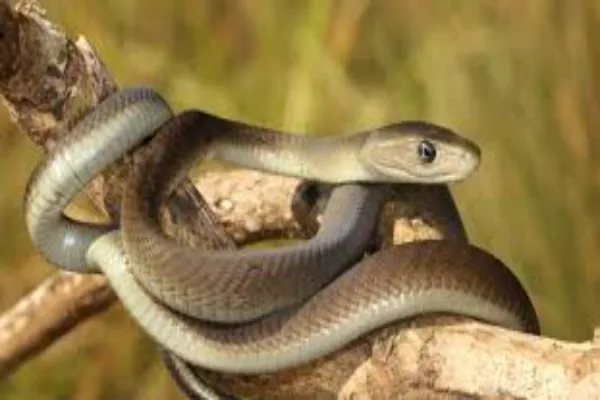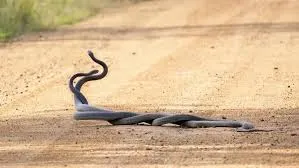
The black mamba (Dendroaspis polylepis) slithers through the savannas and woodlands of sub-Saharan Africa, striking fear into the hearts of many. Feared for their speed, venom, and aggressive tendencies, black mambas are undeniably dangerous snakes. But beyond their fearsome reputation lie some facts that shed light on these remarkable animals. Here are 13 fun facts about black mambas:
1. Not Quite Black (But Definitely Deadly) Mamba

Despite their name, black mambas aren’t actually black. Their scales range from olive gray to a dull brownish yellow. So, where does the black come in? The inside of their mouths is a menacing ebony, which they gape open as a warning to potential threats. This inky black lining is a stark contrast to the lighter mouth colors of many other snake species, making it a clear and unmistakable signal.
2. Mambas are Speed Demons of the Snake World

Black mambas hold the title of the fastest snake in Africa, slithering at speeds of up to 10 to 12 miles per hour (16 to 19 kilometers per hour) on short bursts. While they can’t maintain this speed for long distances, it’s enough to outrun most humans. Their speed is an excellent defense mechanism, allowing them to escape predators or catch unsuspecting prey.
3. Fearsome Fighters (But Not Always)

Black mambas are known for their aggressive behavior, particularly when cornered or threatened. They will readily strike, injecting a potent neurotoxic venom that can be fatal to humans if left untreated. However, contrary to popular belief, they aren’t always out for blood. If given a clear escape route, they often prefer to avoid confrontation.
4. A Lifelong Appetite

Black mambas are active hunters, feeding primarily on small mammals, birds, and lizards. Their keen eyesight and excellent sense of smell help them locate prey. Once they strike, their venom acts quickly, paralyzing the victim within minutes. Black mambas are predatory powerhouses, with a single bite potent enough to kill a human if not treated promptly.
5. Cooperative Childcare (Sort Of)

Unlike many other snakes that scatter their eggs and leave their young to fend for themselves, black mambas exhibit a surprising degree of parental care. The females lay clutches of up to 20 eggs and will coil around them, providing warmth and protection until they hatch. However, once the young emerge, they are on their own and must fend for themselves.
6. King of the Savannah Strike: A Look at Black Mambas in Sub-Saharan Africa
Slithering through the sun-drenched savannas and woodlands of sub-Saharan Africa, the black mamba reigns supreme. This venomous serpent, while not actually black (their scales are typically olive gray to brownish yellow), strikes fear into the hearts of many with its potent neurotoxic venom and lightning-fast strikes.

Black mambas are Africa’s fastest snake, capable of short bursts exceeding 10 miles per hour, making them formidable predators that prey on small mammals, birds, and lizards. Despite their fearsome reputation, they generally prefer to avoid confrontation when given the chance, but their aggressive defense mechanisms when cornered make them a force to be reckoned with in the African wild.
7. Beyond the Bite: The Black Mamba’s Nuanced Behavior
Black mambas are often portrayed as relentless aggressors, but their behavior is more nuanced. While they possess a potent neurotoxic venom capable of taking down prey or deterring threats, they generally prefer to avoid confrontation. This “fight or flight” instinct kicks in when they feel cornered or threatened. Despite their fearsome reputation, they are active hunters, strategically utilizing their keen eyesight and sense of smell to locate small mammals, birds, and lizards – their primary food source. If escape isn’t an option, they’ll strike swiftly, injecting their deadly venom to subdue their prey.
8. A Venomous Arsenal of Black Mambas

Black mamba venom is a neurotoxic cocktail, meaning it targets the nervous system. This potent mix of toxins disrupts nerve signals, leading to paralysis, difficulty breathing, and ultimately, respiratory failure if left untreated. Symptoms can appear within minutes, making swift medical attention crucial. The amount of venom injected varies depending on factors like the size and aggression of the snake, but even small doses can be fatal.
9. The Antidote for Black Mamba Bites: A Race Against Time

Thankfully, an antivenom specifically designed for black mamba bites exists. This life-saving treatment works by introducing antibodies that neutralize the venom’s toxins. However, time is of the essence. The effectiveness of antivenom decreases significantly the longer the bite goes untreated.
10. Administering Antivenom for Mambas Venom

Black mamba antivenom is typically administered intravenously (through a vein) in a controlled medical setting. Multiple doses may be required depending on the severity of the bite. It’s important to note that antivenom can have side effects, such as allergic reactions, but these are usually manageable compared to the effects of untreated venom.
11. Prevention of Black Mambas is Key

The best defense against a black mamba bite is to avoid encounters altogether. Be aware of their habitats in sub-Saharan Africa and avoid areas with high black mamba populations. Wear protective footwear when venturing into tall grass or rocky areas where they might be hiding.
12. The Black Mamba’s Ebon Warning Sign

The black mamba’s namesake doesn’t come from its scales, which range from olive gray to a dull brownish yellow. Instead, it’s their inky black mouth lining that gives them their fearsome reputation. This stark contrast to the lighter mouth colors of most snakes serves a critical purpose. When threatened, black mambas gape wide, revealing their ebony maw as a clear and unmistakable warning to potential attackers. This dramatic display is a potent visual deterrent, a silent scream that says, “Back off, or face the consequences.”
13. A Shrinking Sanctuary: How Habitat Loss Threatens Black Mambas

While black mambas are a force to be reckoned with, they face their own challenges in the wild. Habitat loss is a major threat to these slithering sentinels. The conversion of savannas and woodlands for agriculture, urbanization, and resource extraction fragments their natural habitat, disrupting their hunting grounds and breeding areas. This can lead to population decline and increased conflict with humans as their territories shrink. Conservation efforts focused on protecting these vital ecosystems are crucial for ensuring the survival of black mambas and the rich biodiversity they share their habitat with.
Living Alongside a Legend

Black mambas are a force to be reckoned with in the African wild. Their potent venom, lightning-fast speed, and defensive behavior make them worthy of respect. However, understanding these dangerous animals can help us appreciate their role in the ecosystem and coexist peacefully with these remarkable snakes.
Leave a Reply